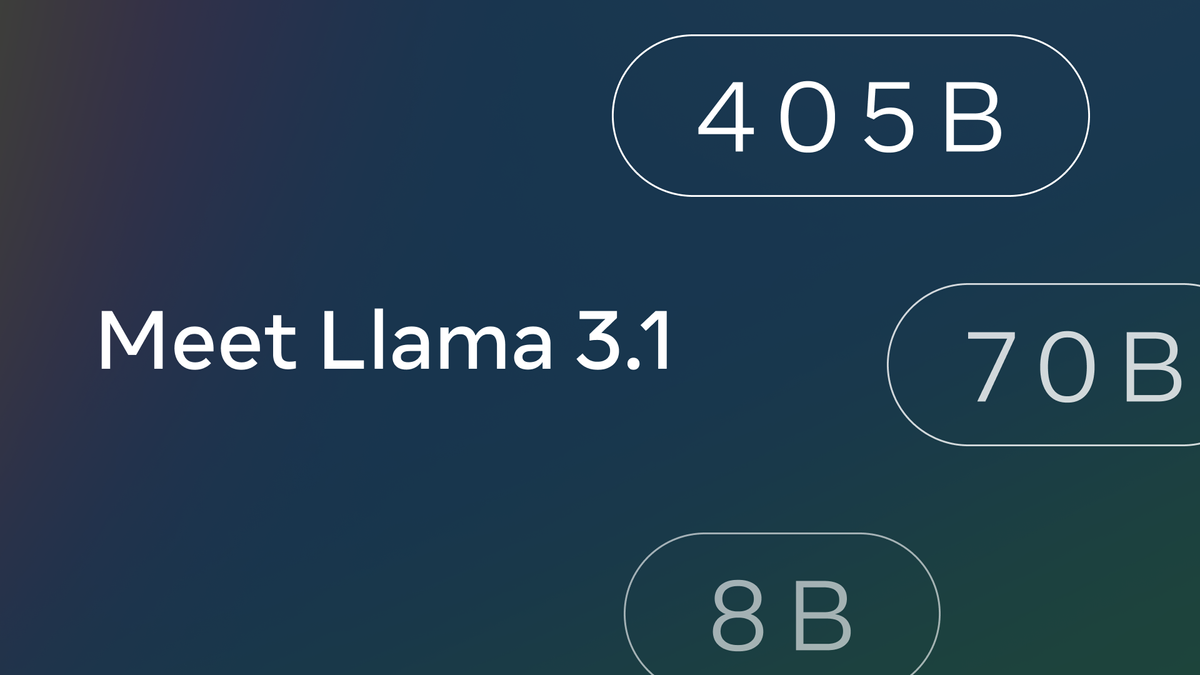Introducing Llama 3.1: Meta's Latest Language Model

Meta's latest advancement in AI, Llama 3.1, offers improved language model performance and efficiency. Building on the foundation of its predecessor, Llama 3.0, this update introduces enhancements in model size, training data, and fine-tuning capabilities. These improvements make Llama 3.1 more adept at handling complex tasks, generating nuanced responses, and providing better scalability and accessibility.
Designed for various real-world applications, from customer support to content generation, Llama 3.1 represents a significant step in Meta's commitment to advancing AI technology and its practical use.
Advancements in AI: Presenting Llama 3.1
Starting today, open source is leading the way. Introducing Llama 3.1: Our most capable models yet.
— AI at Meta (@AIatMeta) July 23, 2024
Today we’re releasing a collection of new Llama 3.1 models including our long awaited 405B. These models deliver improved reasoning capabilities, a larger 128K token context… pic.twitter.com/1iKpBJuReD
Meta's AI team is excited to announce Llama 3.1, the newest iteration of our large language model (LLM). Building on the success of Llama 3.0, this version introduces several enhancements aimed at improving performance, scalability, and utility for various applications.
Enhanced Performance and Capabilities

Llama 3.1 brings significant upgrades in terms of both performance and efficiency. It leverages advanced optimization techniques and architecture refinements, resulting in a model that is not only more powerful but also more efficient in resource utilization. Key improvements include:

- Increased Model Size: Llama 3.1 features an expanded architecture with more parameters, enabling it to handle more complex tasks and generate more nuanced responses.
- Improved Training Data: The training dataset for Llama 3.1 has been significantly expanded and diversified, leading to better generalization and contextual understanding.
- Enhanced Fine-Tuning: The fine-tuning process has been optimized, allowing for more precise adjustments to specific domains or tasks, enhancing the model's adaptability and performance in specialized applications.
Scalability and Accessibility
One of the primary goals with Llama 3.1 is to ensure scalability and accessibility for developers and businesses. We've made several strides in this area, including:
- Optimized Deployment: Llama 3.1 has been designed for efficient deployment across various environments, from local machines to cloud infrastructures, ensuring that users can leverage its capabilities regardless of their technical setup.
- Reduced Latency: Through various optimizations, Llama 3.1 offers lower latency, making it more responsive and suitable for real-time applications.
- Cost-Effective Solutions: Despite its increased capabilities, Llama 3.1 remains cost-effective, making it accessible for a wider range of users and use cases.
Real-World Applications
Llama 3.1 is poised to make a significant impact across multiple industries. Some of the key applications include:
- Customer Support: Enhanced natural language understanding allows for more accurate and efficient handling of customer queries, improving user satisfaction and reducing operational costs.
- Content Generation: Llama 3.1 can assist in creating high-quality content across various domains, from technical documentation to creative writing, boosting productivity and creativity.
- Data Analysis: The model's advanced capabilities enable more sophisticated data analysis, providing deeper insights and more actionable intelligence for businesses.
Collaboration and Future Directions
At Meta, we believe in the power of collaboration to drive innovation. Llama 3.1 is a testament to our ongoing commitment to working with the broader AI community to push the boundaries of what's possible. Looking ahead, we plan to continue enhancing our models, focusing on areas such as ethical AI, bias reduction, and further improving performance and accessibility.
Explore the Llama 3.1 Model Collection Today
The AI community is eagerly anticipating the potential of Llama 3.1. With its enhanced multilingual capabilities and extended context length, the opportunities for creating innovative and helpful experiences are immense. The inclusion of the Llama Stack and new safety tools underscores a commitment to responsible development in collaboration with the open source community.
Before any model is released, extensive efforts are made to identify, evaluate, and mitigate risks through various measures, including pre-deployment risk discovery exercises and safety fine-tuning. This rigorous process involves comprehensive red teaming by both external and internal experts to stress test the models and discover any unexpected uses.

.png)
